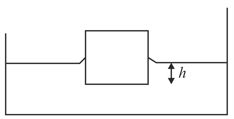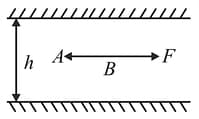The velocity of liquid $(v)$ in steady flow at a location through cylindrical pipe is given by $v=v_{0}\left(1-\frac{r^{2}}{R^{2}}\right)$, where $r$ is the radial distance of that location from the axis of the pipe and $R$ is the inner radius of pipe, if $R=10 \mathrm{~cm}$, volume rate of flow through the pipe is $\pi / 2 \times 10^{-2} \mathrm{~m}^{3} \mathrm{~s}^{-1}$ and the coefficient of viscosity of the liquid is $0.75 \mathrm{~N} \mathrm{~s} \mathrm{~m}^{-2}$

Important Questions on Surface Tension and Viscosity
A cube of side and mass just floats on the surface of water as shown in the figure. The surface tension and density of water are and , respectively. If angle of contact between cube and water surface is zero, find the distance (in metres) between the lower face of cube and surface of the water.
(Take unit and unit )

A thin plate of large area is placed symmetrically in a small gap of height filled with water of viscosity and the plate has a constant velocity by applying a force as shown in the figure. If the gap is filled with some other liquid of viscosity , at what minimum distance (in ) from minimum distance (in ) from top wall should the plate be placed in the gap, so that the plate can again be pulled at the same constant velocity , by applying the same force (Take )

